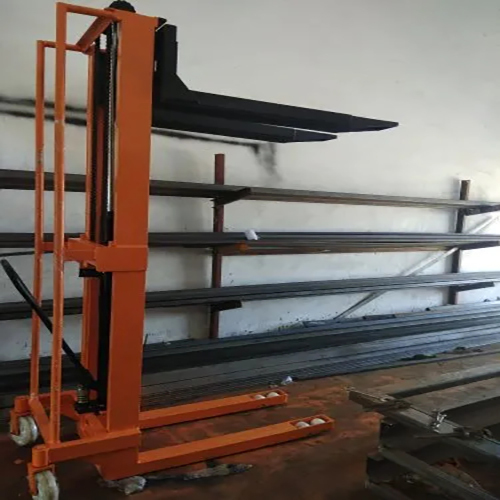
Hydraulic Lift Pallet Stacker
45000 INR/Unit
Product Details:
- Usage Industrial
- Condition New
- Feature High efficiency, Rust proof
- Warranty Yes
- Attributes Strong
- Click to View more
X
Hydraulic Lift Pallet Stacker Price And Quantity
- 45000 INR/Unit
- 1 Unit
Hydraulic Lift Pallet Stacker Product Specifications
- Industrial
- High efficiency, Rust proof
- Strong
- Yes
- New
Hydraulic Lift Pallet Stacker Trade Information
- Gujarat
Product Description
A hydraulic lift pallet stacker is a type of material handling equipment designed to lift, move, and stack pallets and other heavy loads using a hydraulic system. These stackers are widely used in warehouses, manufacturing plants, and distribution centers to efficiency and safety in handling goods. Here are the key features and components of a hydraulic lift pallet stacker:
Key Features
- Hydraulic System: Utilizes a hydraulic pump to lift and lower the forks. The system may be manually operated or powered by an electric motor, ensuring smooth and controlled lifting and lowering of loads.
- Mast and Forks: Features a sturdy mast and adjustable forks that can be raised or lowered to handle pallets of various sizes and heights.
- Control Handle: Includes a control handle or tiller with levers for operating the stacker, including lifting, lowering, and directional movement.
- Load Capacity: Typically ranges from 500 to 2,000 kg (1,100 to 4,400 lbs), depending on the model and design.
- Lift Height: Capable of lifting loads to varying heights, with some models offering lift heights up to 4 meters (13 feet) or more.
- Mobility: Fitted with durable wheels or casters for easy movement and maneuverability, often with options for different wheel materials to suit various floor types.
- Safety Features: Equipped with safety mechanisms such as an emergency stop button, overload protection, and safety guards to prevent accidents.
- Construction: Built with robust materials to withstand heavy use and provide long-lasting durability.
- Efficiency: productivity by enabling quick and easy movement and stacking of heavy loads.
- Ergonomics: Reduces physical strain on workers, minimizing the risk of injuries associated with manual lifting.
- Versatility: Suitable for a wide range of applications, from stacking pallets to loading and unloading goods.
- Precision: The hydraulic system provides precise control over lifting and lowering, ensuring safe and accurate handling of loads.
- Cost-Effective: Manual hydraulic stackers can be more affordable compared to fully electric models, making them a cost-effective solution for many businesses.
- Manual Hydraulic Stacker: Operated manually, requiring physical effort to move and position the stacker, with a hydraulic pump to lift and lower the forks.
- Semi-Electric Hydraulic Stacker: Combines manual movement with an electric hydraulic system for lifting, suitable for moderate usage.
- Fully Electric Hydraulic Stacker: Offers both electric movement and hydraulic lifting, ideal for frequent and heavy-duty applications.
- Warehousing: Efficiently stacks and retrieves pallets in storage environments.
- Manufacturing: Moves raw materials and finished products within production facilities.
- Retail: Assists in restocking shelves and organizing inventory in retail stores.
- Logistics: Facilitates the loading and unloading of trucks and containers in distribution centers.
- Cold Storage: Suitable for use in refrigerated environments, with models designed to withstand low temperatures.
- Hydraulic Pump: Manually or electrically operated, responsible for lifting and lowering the forks.
- Control Valve: Regulates the flow of hydraulic fluid, allowing precise control over the lifting mechanism.
- Hydraulic Cylinder: Converts hydraulic pressure into mechanical force to lift the load.
- Forks: Adjustable prongs that can accommodate different pallet sizes and loads.
- Mast: The vertical support structure that guides the forks during lifting and lowering.
- Wheels/Casters: Provide mobility and stability, with options for different materials based on the operating environment.
- Hydraulic lift pallet stackers are essential tools in material handling, offering a balance of power, precision, and affordability to streamline operations in various industries.
Tell us about your requirement

Price:
Quantity
Select Unit
- 50
- 100
- 200
- 250
- 500
- 1000+
Additional detail
Mobile number
Email








